ThisiscontentfromElsevier'sDrugInformation
Antihemophilic Factor, Fc Fusion Protein, Recombinant
Learn more about Elsevier's Drug Information today! Get the drug data and decision support you need, including TRUE Daily Updates™ including every day including weekends and holidays.
50 International Units/kg/dose IV as a single dose. For minor and moderate bleeding episodes occurring within 2 to 3 days after a prophylactic dose, a lower dose of 30 International Units/kg/dose IV may be used. May give additional doses of 30 or 50 International Units/kg/dose IV every 2 to 3 days if needed.[68666]
50 International Units/kg/dose IV as a single dose. For minor and moderate bleeding episodes occurring within 2 to 3 days after a prophylactic dose, a lower dose of 30 International Units/kg/dose IV may be used. May give additional doses of 30 or 50 International Units/kg/dose IV every 2 to 3 days if needed.[68666]
20 to 30 International Units/kg/dose IV every 24 to 48 hours until bleeding is resolved.[57379]
20 to 30 International Units/kg/dose IV every 24 to 48 hours until bleeding is resolved.[57379]
20 to 30 International Units/kg/dose IV every 12 to 24 hours until bleeding is resolved.[57379]
50 International Units/kg/dose IV as a single dose. May give additional doses of 30 or 50 International Units/kg/dose IV every 2 to 3 days if needed.[68666]
50 International Units/kg/dose IV as a single dose. May give additional doses of 30 or 50 International Units/kg/dose IV every 2 to 3 days if needed.[68666]
40 to 50 International Units/kg/dose IV every 12 to 24 hours until bleeding is resolved (approximately 7 to 10 days).[57379]
40 to 50 International Units/kg/dose IV every 12 to 24 hours until bleeding is resolved (approximately 7 to 10 days).[57379]
40 to 50 International Units/kg/dose IV every 8 to 24 hours until bleeding is resolved (approximately 7 to 10 days).[57379]
50 International Units/kg/dose IV as a single dose preoperatively. May give an additional dose of 30 or 50 International Units/kg/dose IV after 2 to 3 days if needed.[68666]
50 International Units/kg/dose IV as a single dose preoperatively. May give an additional dose of 30 or 50 International Units/kg/dose IV after 2 to 3 days if needed.[68666]
25 to 40 International Units/kg/dose IV every 24 hours; continue for at least 1 day until wound healing is achieved.[57379]
25 to 40 International Units/kg/dose IV every 24 hours; continue for at least 1 day until wound healing is achieved.[57379]
25 to 40 International Units/kg/dose IV every 12 to 24 hours; continue for at least 1 day until wound healing is achieved.[57379]
50 International Units/kg/dose IV as a single dose preoperatively. May give additional doses of 30 or 50 International Units/kg/dose IV every 2 to 3 days as clinically needed.[68666]
50 International Units/kg/dose IV as a single dose preoperatively. May give additional doses of 30 or 50 International Units/kg/dose IV every 2 to 3 days as clinically needed.[68666]
40 to 60 International Units/kg/dose IV as a single dose preoperatively, followed by 40 to 50 International Units/kg/dose IV after 8 to 24 hours. Repeat every 24 hours until adequate wound healing and then continue for at least 7 days to maintain a factor VIII activity within the target range.[57379]
40 to 60 International Units/kg/dose IV as a single dose preoperatively, followed by 40 to 50 International Units/kg/dose IV after 8 to 24 hours. Repeat every 24 hours until adequate wound healing and then continue for at least 7 days to maintain a factor VIII activity within the target range.[57379]
40 to 60 International Units/kg/dose IV as a single dose preoperatively, followed by 40 to 50 International Units/kg/dose IV after 6 to 24 hours. Repeat every 24 hours until adequate wound healing and then continue for at least 7 days to maintain a factor VIII activity within the target range.[57379]
50 International Units/kg/dose IV once weekly.[68666]
50 International Units/kg/dose IV once weekly.[68666]
50 International Units/kg/dose IV every 4 days initially. Adjust dose based on response. The typical dosing range is 25 to 65 International Units/kg/dose IV every 3 to 5 days.[57379]
50 International Units/kg/dose IV every 4 days initially. Adjust dose based on response. The typical dosing range is 25 to 65 International Units/kg/dose IV every 3 to 5 days.[57379]
50 International Units/kg/dose IV twice weekly initially. Adjust dose based on response. The typical dosing range is 25 to 65 International Units/kg/dose IV every 3 to 5 days. More frequent or higher doses up to 80 International Units/kg/dose IV may be needed in some patients.[57379]
Specific guidelines for dosage adjustments in hepatic impairment are not available; it appears that no dosage adjustments are needed.
Specific guidelines for dosage adjustments in renal impairment are not available; it appears that no dosage adjustments are needed.
† Off-label indication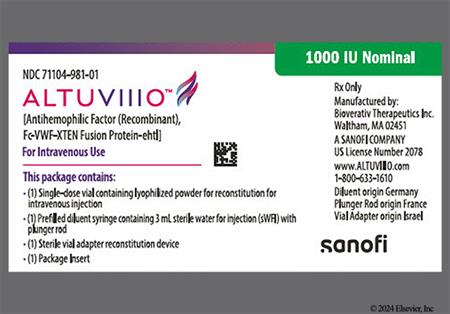


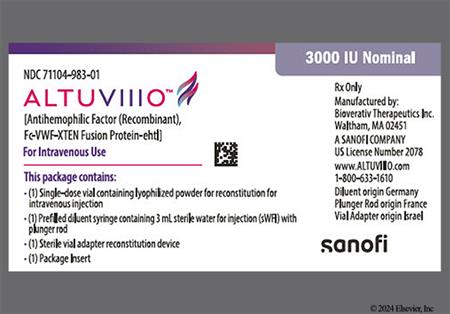
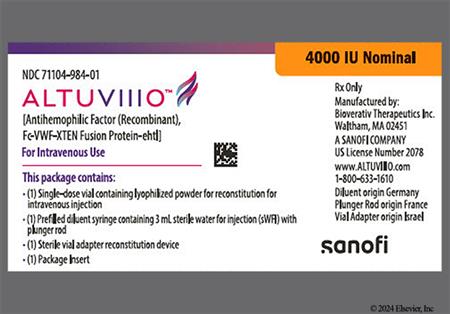
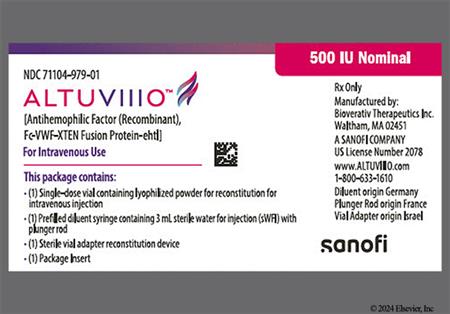
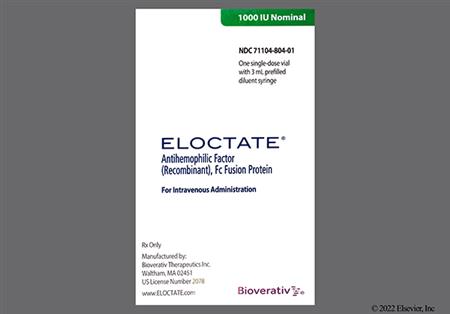
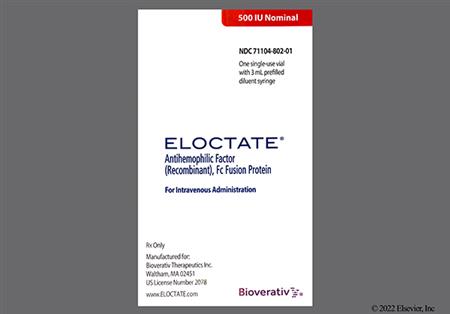
Antihemophilic factor, Fc fusion protein, recombinant is approved for patients with hemophilia A for control and prevention of bleeding episodes, management of bleeding during surgical procedures, and routine prophylaxis to prevent or reduce the frequency of bleeding episodes. The antihemophilic factor is linked to the Fc protein fragment of antibodies, which prolongs factor circulation in the body and extends time between prophylactic infusions. The product is produced by recombinant DNA technology; no human or animal derived proteins are used in the formulation or purification process. Two dedicated viral clearance steps are also incorporated into the production process. The Altuviiio product has a prolonged half-life (approximately 3-fold) compared to the Eloctate product, allowing for less frequent dosing. Eloctate was FDA-approved in 2014 and Altuviiio was FDA-approved in 2023.[57379][68666]
For storage information, see the specific product information within the How Supplied section.
Reconstitution (Altuviiio and Eloctate)
Intermittent IV Infusion
Hypersensitivity reactions, including anaphylactoid reactions, are possible with recombinant antihemophilic factor Fc fusion protein. Early signs of hypersensitivity reactions include angioedema, chest tightness, dyspnea, wheezing, urticaria, and pruritus. Other signs and symptoms of hypersensitivity reactions reported with antihemophilic factor Fc fusion protein include hypotension, nausea, and vomiting. Rash was reported in 0.7% to 1% of pediatric and adult subjects during clinical trials of recombinant antihemophilic factor Fc fusion protein. Two subjects were withdrawn from the study due to rash and joint pain. Discontinue recombinant antihemophilic factor Fc fusion protein if hypersensitivity symptoms occur, and initiate appropriate treatment.[57379] [68666]
Antibody formation, including neutralizing antibodies (inhibitors), to factor VIII can occur after the administration of recombinant antihemophilic factor Fc fusion protein. In clinical trials in previously untreated subjects (n = 103), development of neutralizing antibodies (inhibitors) was observed in 28 subjects (27%); 14 of them had a high-titer inhibitor. Based on subjects with an inhibitor test after an exposure day (ED) milestone or who developed an inhibitor at any time during the study, the incidence of factor VIII inhibitor development was 28/90 subjects (31.1%) with at least 10 EDs and 28/86 subjects (32.6%) with at least 50 EDs. The median time to inhibitor development for the 28 subjects was 9 EDs (interquartile range: 6.5 to 12).[57379] During treatment (median treatment duration 96.3 weeks) in the clinical studies of another recombinant antihemophilic factor Fc fusion protein product, 4/276 (1.4%) subjects developed anti-drug antibodies (ADAs). There was no impact of ADAs on factor VIII activity concentrations, pharmacokinetic exposure parameters, bleeding episodes, or pharmacodynamic response. No subjects developed neutralizing antibodies.[68666] The observed incidence of ADAs is highly dependent on the sensitivity and specificity of the assay. Differences in assay methods preclude meaningful comparisons of the incidence of ADAs in various studies or between different factor VIII products. Monitor all individuals for the development of factor VIII inhibitors utilizing appropriate clinical observations and laboratory tests. Consider the presence of inhibitors if the expected factor VIII activity concentrations in plasma are not attained or if bleeding is not controlled with the recommended dose of antihemophilic factor Fc fusion protein.[57379] [68666]
Arthralgia (13% to 16.4%), back pain (4%), and pain in extremity (4%) were reported in adolescents and adults during clinical trials (n = 233) of recombinant antihemophilic factor Fc fusion protein.[68666] In clinical trials with another recombinant antihemophilic factor Fc fusion protein product in pediatric and adult patients, malaise, myalgia, and arthralgia were reported in 2 of 276 patients (0.7%). Other musculoskeletal and general adverse reactions reported in 1 of 276 patients (0.4%) include joint swelling, back pain, and feeling hot or cold. Two patients were withdrawn from the study due to rash and arthralgia.[57379]
Headache (15% to 20.1%) and fever (4% to 12.2%) were reported in adolescents and adults during clinical trials (n = 223) of recombinant antihemophilic factor Fc fusion protein.[68666] In clinical trials (n = 276) with another recombinant antihemophilic factor Fc fusion protein product in pediatric and adult patients, headache (0.7%), dysgeusia (0.4%), and dizziness (0.4%) were reported.[57379]
Vomiting (3%) was reported in adolescents and adults during clinical trials (n = 233) of recombinant antihemophilic factor Fc fusion protein.[68666] Lower abdominal pain was reported in 1 out of 276 patients (0.4%) during clinical trials of recombinant antihemophilic factor Fc fusion protein in pediatric and adult patients.[57379]
Cardiovascular-related adverse reactions reported in 1 of 276 patients (0.4%) during clinical trials of recombinant antihemophilic factor Fc fusion protein in pediatric and adult patients included bradycardia, hypertension, procedural hypotension, hot flush, and chest pain (unspecified).[57379]
Cough was reported in 1 of 276 patients (0.4%) during clinical trials of recombinant antihemophilic factor Fc fusion protein in pediatric and adult patients.[57379]
Injection site reaction, manifested as infusion site pain, was reported in 1 of 276 patients (0.4%) during clinical trials of recombinant antihemophilic factor Fc fusion protein in pediatric and adult patients.[57379]
Device-related thrombosis, including deep vein thrombosis, was reported in 1.9% (n = 2/103) of previously untreated patients receiving recombinant antihemophilic factor Fc fusion protein during clinical trials.[57379] In the long term safety extension study of another recombinant antihemophilic factor Fc fusion protein product, thromboembolic events (unspecified) occurred in 1% (n = 3/261) of patients; however, these 3 patients had pre-existing risk factors.[68666]
If assessment of plasma factor VIII activity is needed in individuals receiving Altuviiio, use a validated 1-stage clotting assay. Use of a chromogenic assay and a specific ellagic acid based aPTT reagent in 1-stage clotting assay may result in laboratory test interference. Specifically, these assays may overestimate the factor VIII activity by approximately 2.5-fold. If these assays are used, divide the result by 2.5 to approximate the individual's factor VIII activity. Use of a reference laboratory is recommended when a qualified 1-stage clotting assay or chromogenic assay is not available locally.[68666] For Eloctate, plasma factor VIII activity can be monitored using either a chromogenic assay or a 1-stage clotting assay routinely used in US clinical laboratories.[57379]
The coadministration of certain medications may lead to harm and require avoidance or therapy modification; review all drug interactions prior to concomitant use of other medications.
This medication is contraindicated in patients with a history of hypersensitivity to it or any of its components.
If a central venous catheter is required, consider the risks of complications, including local infections, bacteremia, and catheter-site thrombosis.[57379]
Once clotting has been normalized by treatment with recombinant antihemophilic factor Fc fusion protein, hemophilic individuals with cardiovascular risk factors or cardiovascular disease may be at the same risk to develop cardiovascular events as non-hemophilic individuals.[57379]
Data are insufficient to advise a drug-associated risk of recombinant antihemophilic factor Fc fusion protein use during pregnancy. Animal reproductive and developmental toxicity studies have not been conducted. In a placental transfer study, antihemophilic factor Fc fusion protein was detected in murine fetal blood at approximately 1% of the maternal blood concentrations, 3 to 4 hours after a dose 260 to 650 times the clinical human dose. Administer antihemophilic factor Fc fusion protein during pregnancy only if clearly needed. If administered, advise the patient that the risks to the pregnant person and fetus are unknown.[57379] [68666]
There are no data on the presence of antihemophilic factor Fc fusion protein in human milk, its effects on the breast-fed child, or its effects on milk production. Consider the benefits of breast-feeding, the patient's clinical need for antihemophilic factor Fc fusion protein, and any potential adverse effects on the breastfed child from the medication or from the underlying maternal medical condition.[57379] [68666]
In patients with hemophilia A, there is a deficiency of functional coagulation factor VIII (FVIII) leading to a prolonged clotting time in the activated partial thromboplastin time (aPTT) assay. Administration of recombinant antihemophilic factor Fc fusion protein normalizes the aPTT over the effective dosing period. Antihemophilic factor Fc fusion protein is a fully recombinant, fusion protein that temporarily replaces the missing coagulation factor VIII needed for effective hemostasis. Antihemophilic factor Fc fusion protein contains the Fc region of human IgG1, which binds to the neonatal Fc receptor (FcRn). FcRn is part of a naturally occurring pathway that delays lysosomal degradation of immunoglobulins by cycling them back into circulation and prolonging their plasma half-life.[57379][68666]
Mechanism of half-life extension with Altuviiio
Altuviiio is a recombinant FVIII analogue fusion protein that is independent of endogenous von Willebrand factor (VWF) in order to overcome the half-life limit imposed by FVIII-VWF interactions. The D'D3 domain of VWF is the region that interacts with FVIII. Appending the D'D3 domain of VWF to a recombinant FVIII-Fc fusion protein provides protection and stability to FVIII, and prevents FVIII interaction with endogenous VWF, thus overcoming the limitation on FVIII half-life imposed by VWF clearance. Altuviiio contains 2 XTEN polypeptides, which alter the hydrodynamic radius of the fusion protein, thus reducing rates of clearance and degradation, and improving pharmacokinetic properties. In Altuviiio, the natural FVIII B domain (except 5 amino acids) is replaced with the first XTEN, inserted in between FVIII N745 and E1649 amino acid residues, and the second XTEN is inserted in between the D'D3 domain and Fc.[68666]
Revision Date: 08/13/2025, 01:32:00 AMRecombinant antihemophilic factor Fc fusion protein is administered intravenously. Pharmacokinetic parameters obtained in clinical studies with both products were based on plasma factor VIII activity measured by the 1-stage clotting assay. Altuviiio has demonstrated 3- to 4-fold prolonged half-life relative to other standard and extended half-life factor VIII products.[57379][68666]
Altuviiio
The pharmacokinetics of Altuviiio were evaluated in clinical studies in adult patients (n = 134) receiving weekly IV doses of 50 International Units/kg. After a single dose of 50 International Units/kg, Altuviiio exhibited high sustained factor VIII activity with prolonged half-life across age cohorts. The pharmacokinetic profile at steady state (Week 26) was comparable with the pharmacokinetic profile obtained after the first dose. The factor VIII activity over 10 International units/dL was maintained in 83.5% of adults throughout the study.[68666]
Eloctate
The pharmacokinetics of Eloctate were evaluated in clinical studies in adult patients (n = 26) receiving a single 50 International Unit/kg/dose. The pharmacokinetic profile at steady state (Week 14) was comparable with the pharmacokinetic profile obtained after the first dose.[57379]
Affected cytochrome P450 isoenzymes: none
Altuviiio
The pharmacokinetics of Altuviiio were evaluated in clinical studies in pediatric patients 1 to 17 years (n = 61) receiving weekly IV doses of 50 International Units/kg. Among children younger than 12 years, 37 subjects had Altuviiio single dose pharmacokinetic profiles available. After a single dose of 50 International Units/kg, Altuviiio exhibited high sustained factor VIII activity with prolonged half-life across age cohorts. There was a trend toward increasing AUC and decreasing clearance, with increasing age in the pediatric cohorts. The pharmacokinetic profile at steady state (Week 26) was comparable with the pharmacokinetic profile obtained after the first dose. The factor VIII activity over 10 International units/dL was maintained in 83.5% of adolescents throughout the study. In children younger than 12 years, Altuviiio maintained normal to near normal (more than 40 International units/dL) factor VIII activity for 2 to 3 days and more than 10 International units/dL factor VIII activity for approximately 7 days.[68666]
Eloctate
The pharmacokinetics of Eloctate were evaluated in clinical studies in pediatric patients 1 to 17 years (n = 65) receiving a single 50 International Unit/kg/dose. The bodyweight-adjusted clearance (CL) was 75% higher in children 1 to 5 years compared to adolescents and adults. This may result in a need for more frequent and/or higher dosing based on body weight in children 1 to 5 years. Pharmacokinetic parameters of subjects 6 to 17 years of age are similar to those of adults, and an age-based dose adjustment is not required in patients 6 years of age and older. The pharmacokinetic profile at steady state (Week 14) was comparable with the pharmacokinetic profile obtained after the first dose.[57379]
The pharmacokinetics of recombinant antihemophilic factor Fc fusion protein are not significantly influenced by gender.[68666]
The pharmacokinetics of recombinant antihemophilic factor Fc fusion protein are not significantly influenced by race.[68666]
The pharmacokinetics of recombinant antihemophilic factor Fc fusion protein are not significantly influenced by von Willebrand factor (VWF) antigen activity (40 to 339 International Units/dL), hematocrit concentration (28% to 57%), blood type, HCV status, or HIV status.[68666]
Data are insufficient to advise a drug-associated risk of recombinant antihemophilic factor Fc fusion protein use during pregnancy. Animal reproductive and developmental toxicity studies have not been conducted. In a placental transfer study, antihemophilic factor Fc fusion protein was detected in murine fetal blood at approximately 1% of the maternal blood concentrations, 3 to 4 hours after a dose 260 to 650 times the clinical human dose. Administer antihemophilic factor Fc fusion protein during pregnancy only if clearly needed. If administered, advise the patient that the risks to the pregnant person and fetus are unknown.[57379] [68666]
There are no data on the presence of antihemophilic factor Fc fusion protein in human milk, its effects on the breast-fed child, or its effects on milk production. Consider the benefits of breast-feeding, the patient's clinical need for antihemophilic factor Fc fusion protein, and any potential adverse effects on the breastfed child from the medication or from the underlying maternal medical condition.[57379] [68666]
Cookies are used by this site. To decline or learn more, visit our cookie notice.
Copyright © 2025 Elsevier, its licensors, and contributors. All rights are reserved, including those for text and data mining, AI training, and similar technologies.